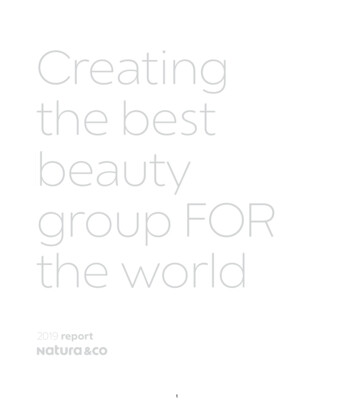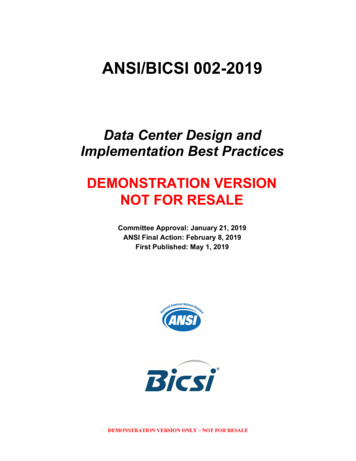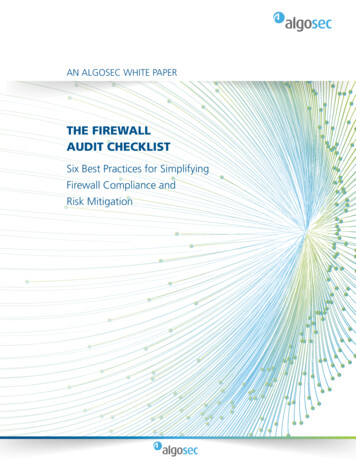
Transcription
Best Practices in Creating and DeliveringLGBTQ CulturalCompetencyTrainingsfor Health and SocialService Agencies
1IntroductionContents1Introduction32Defining Cultural Competency53Goals of LGBTQ Cultural Competency TrainingGoals vs ObjectivesSMART Concept7784Preparing for a TrainingProfessional Use of SelfApplying Appropriate Theories of ChangeKnowing the Audience and SettingMaking Use of the Range of Experiencewith LGBTQ Issues in a GroupSome Challenges of this Material for Adult LearnersWorking with Difficult Participants in a Training2GBTQ cultural competency training is widelyused and highly recommended for staff workingin healthcare settings and social service organizations.Indeed, the federal Department of Health andHuman Services encourages new and existinghuman services programs to include LGBTQcultural competency curricula, as “the lack ofculturally competent providers is a significant barrierto quality health care for many LGBTQ people,particularly those who identify as transgender.”1Funding for this project from the AIDS Instituteof the NY State Department of Health reflects asimilar commitment.1313135Training ComponentsCore Topics6Training MethodsLecture with PowerPoint SlidesGuest Speaker(s)/Panel DiscussionMediaInteractive ParticipationPrint Materials and Learning AidsWeb-based Learning7Training EvaluationKirkpatrick Model (Pyramid) of EvaluationEvaluation Planning Chart8Resources and ExamplesGeneral LGBTQ Health Resources for Updating CurriculaImproving the LGBTQ-friendliness of a Health FacilityMedia TrainingsGuidelines for Creating Good PowerPoint PresentationsResources for Anti-oppression aluation Appendix329L101011121516–1920212323242525While there is broad agreement that LGBTQcultural competency training is valuable, there is nostandardized definition of what cultural competencytraining should entail for a culturally competentprovider of health and human services. There cannotbe a permanent standard of cultural competency, ascommunities, language and policies shift over timeand the requirements for culturally competent caremay differ, based on job responsibilities. Despite theinevitability of change, we need to create currentstandards for “culturally competent care,” even aswe understand the limitations of such a designation.Is an increase in knowledge about this population enough?262729-30Can attitudes about LGBTQ people be changed through cultural competency training?Written by the National LGBTCancer Network: Liz Margolies,Rej Joo and Jenna McDavid.Are modifications in the ways LGBTQ people are treated by providers,i.e., behavior change, the only change that matters?Funded by a grant from theNew York State Departmentof Health, AIDS Institute.Cover image:Rainbow by What personal and institutional changes are needed to reduceLGBTQ health disparities and increase access to care?U.S. Department of Health and Human Services (U.S. DOHHS). (2012). U.S. Department of Health and Human Services recommended actions to improvethe health and well-being of lesbian, gay, bisexual and transgender communities. Retrieved from http://www.hhs.gov/lgbt/health.html1 3
Across the country, curricula have been developedwith one or more of these goals in mind, butwithout grounding in evidence-based research.Various individuals and agencies have created theirown set of slides, lectures, handouts, group exercisesand evaluation tools. Having analyzed approximatelytwo dozen separate cultural competency trainingcurricula, we have found that there is a strikingsimilarity between them all in terms of content,suggesting that exposure to previous trainings, eitherin person or online, has guided new developments.Or, perhaps there is unstated national concurrenceon the shape of the wheel each agency hasindependently created.Research on the effectiveness of LGBTQ-specificcultural competency training is extremely limited andmostly addresses changes in providers. This doesnot necessarily translate into better health outcomesfor LGBTQ people.2 Some intended changes, e.g.,increase in knowledge about LGBTQ terms, canbe more easily measured using pre- and post-testsurveys. Others, like changes in provider behaviorwhen working with LGBTQ patients or clients, aremore difficult and expensive to gauge.This manual does not contain a training curriculum,but is instead intended to be a guide for thosewho plan to create and deliver LGBTQ culturalcompetency trainings to health and human serviceproviders. It was created as a technical assistancetool for LGBT health and human service providersin New York State, but it may also be of benefitto anyone beginning the work of LGBTQ culturalcompetence training across a wide range of agencies,organizations, schools and facilities.The manual offers a conceptual framework thatcoordinates learning theory, training skills, contentand evaluation. The manual is also useful for assessingexisting curricula and for guidance when makingroutine updates. All sections are interrelated, andit is recommended that the manual be read in itsentirety. The design is intended to make it simplefor later reference to the information, as needed.In the absence of solid outcome data, how do wemeasure and define best practices in LGBTQ culturalcompetency trainings? Two separate foundationsground this manual.First, we use well-established theoriesof how adults learn and change, as wedelineate the steps in constructing acurriculum.Second, we rely on community wisdomand experience.This manual reflects the collected years of LGBTQcultural competency training of over 60 differentorganizations and individuals, especially those in theNew York State LGBTQ Health and Human ServicesNetwork who provided an estimated 2,500 LGBTQcultural competency trainings in 2013.3Porter, K. E., & Krinsky, L. (2014). Do LGBT Aging Trainings Effectuate Positive Change in Mainstream Elder Service Providers?. Journal of homosexuality, 61(1),197-216.3 Empire State Pride Agenda. (2011) New york state LGBT health and human services network. Retrieved from tures/2012%20LGBT%20HHS%20Network%20Report.pdf2 42Defining CulturalCompetencyCultural competency training has beenpopularized and widely used across diversefields including the healthcare sector, academicinstitutions and government and social serviceagencies. The term has been used interchangeablywith diversity education, cultural sensitivity trainingand multi-cultural workshops. Cultural competencyis commonly understood as a set of congruentbehaviors, knowledge, attitudes and policies thatenable effective work in cross-cultural situations.4Cultural competency training, therefore, aims toincrease knowledge and skills to improve one’s abilityto effectively interact with different cultural groups. 5LGBTQ cultural competency training has beendeveloped and implemented to improve healthcareand social service delivery to LGBTQ patients andclients and, therefore, decrease LGBTQ healthdisparities. Some of these barriers to care includerefusal of care, delayed and/or substandard care andlack of inclusion in health outreach or education onrisks that affect LGBTQ people.LGBTQ cultural competency training hasbeen supported and recommended bymultiple federal agencies, including the JointCommission.6Some people have argued that cultural competencytrainings are too focused on a prescriptive way ofteaching “culture,” challenging the implicit assumptionthat culture is a discrete body of knowledge thatcan be learned in one setting. Cultural norms andlanguage are constantly changing, and there are largeindividual variabilities within LGBTQ communities.The intersectionalities of people’s identities (e.g.,race, ability and sexual orientation) resist a narrowdefinition of “culture.”“Cultural Humility” is an approach to culturalcompetency trainings that proposes changethrough a lifelong process of learning, includingself-examination and refinement of one’s ownawareness, knowledge, behavior and attitudes onthe interplay of power, privilege and social contexts.7Cross, T., Bazron, B., Dennis, K., & Isaacs, M. (1989). Towards a culturally competent system of care. Volume I. Washington, DC: Georgetown University ChildDevelopment Center, CASSP Technical Assistance Center.5 Beach, M.C., Price, E.G., & Gary, T.L. (2005). Cultural competence: a systematic review of health care provider educational interventions. Medical Care, (43),356–373.6 The Joint Commission. (2011). Advancing effective communication, cultural competence, and patient- and family-centered care for the lesbian, gay, bisexual,and transgender (LGBT) community. Retrieved from ldGuide.pdf7 Tervalon, M. & Murray-Garcia, J. (1998) Cultural humility versus cultural competence: A critical distinction in defining physician-training outcomes inmulticultural education. Journal of Health Care for the Poor and Underserved, 9(2), 117.4 5
When incorporating cultural humility into practice,participants are invited to challenge their own uniqueset of biases and privileges that impact the LGBTQpatients and clients they work with.People often use the word ‘presentation’interchangeably with the word ‘training’. However,there are important distinctions between the twomethods. Presentations are a form with moreemphasis on instruction and slides, requiring trainerskills of public speaking, slide development and groupengagement.8 They are best for short time framesand very large groups.9 Trainings are more focusedon facilitating group and individual activities and fitwill with the cultural humility model. In reality, mostcultural competency workshops include aspects ofboth presentations and trainings.In this best practices manual, we will continue touse the terms “cultural competency” and “training”as they are the words most used by agencies andhealthcare facilities, but we expand the definitionsto take in the complexities that the cultural humilityapproach offers and understand that most culturalcompetency work involves both training andpresentations. We will define cultural competencynot as an end goal but as a commitment to anongoing engagement with LGBTQ-affirmingbehaviors, knowledge, attitudes and policies. LGBTQcultural competency presentations and trainings areunderstood to be a beginning and important stepin learning to work more effectively with LGBTQclients/patients, but they are not the only requiredstep. Profound change also requires time, practiceand self-reflection.We will use the term “trainer” to refer tothe people who lead both cultural competencypresentations and trainings, and we will refer tothose who attend them as “participants.”NOTEBowhay, S. Training vs. presenting. British Counsil. Retrieved from g-versus-presenting.pdf9 Meyerson, D. (2013). The key differences between presenting, training and facilitating. Management Consultancy International.Retrieved from een-presenting-training-and-facilitating863The Goals ofLGBTQ CulturalCompetency TrainingMost cultural competency trainings share similar goals:to bring about positive, LGBTQ-affirming change inthe participants’ knowledge, attitude and behavior towardsLGBTQ patients and clients. The priority placed on eachseparate goal may differ with the audience and setting, but itis critical to be intentional in goal setting. The specific goals ofa cultural competency training will inform the topics covered,the training methods used, the choice of exercises and/or caseexamples and, most importantly, the evaluation approach.While it is tempting to try to cover as many LGBTQtopics and goals as time will allow, participants becomeoverwhelmed when given a great deal of new information,resulting in a loss of interest and/or mental withdrawal.Training goals are best when they are realistic and attainablefor the specific audience and time permitted.Bias and prejudice tend to function at many levels,including personal, interpersonal and institutional. Thestrategies proposed here focus primarily on the personaland interpersonal levels, with an understanding thattransformation at these levels can exercise an influenceon institutions. Also, few participants in LGBTQ culturalcompetency trainings have the authority to make majorinstitutional changes, even as it is understood that suchchanges may have the greatest impact on eliminatingLGBTQ barriers to quality care. Separate trainings foradministrative and policy staff may better achieve thegoals of institutional change.Goals vs. ObjectivesThe terms “goals” and “objectives” areoften considered synonymous, but theyare not identical. Goals are broad desiredoutcomes for the trainings, while objectivesare more specific, concrete and easilymeasured targets for achieving the goals.10Each goal may have multiple objectives.The goals and objectives of the culturalcompetency training will determine theevaluation measures, optimal teachingmethods and training content.Bogue, R. Use S.M.A.R.T. goals to launch managementby objectives plan. Retrieved from -launch-management-byobjectives-plan/#.10 7
Common LGBTQ CulturalCompetency TrainingGoals Are:1. T o increase knowledge aboutLGBTQ health/social serviceneeds.2. To increase LGBTQ-affirmingattitude3. To increase LGBTQ-affirmingbehaviorExample 1TO rally, knowledge-based goals are the easierto change than attitude or behavior-based goals.Goal: To increase knowledge about LGBTQ health and social service needs.Unmeasurable objective: To understand risk factors that account for LGBTQ health disparities.SMART objective: By the end of the 1.5-hour training, participants will be able to identify at least 3risk factors that contribute to LGBTQ health disparities.Possible trai
Media Trainings 32 i.e., behavior change, the only change that matters?Guidelines for Creating Good PowerPoint Presentations 32 New York State Department Resources for Anti-oppression Trainings 32 Accessibilityof Health, AIDS Institute.32 Evaluation 32 9 Evaluation Appendix 32 LGBTQ cultural competency training is widely used and highly recommended for staff working in healthcare settings











